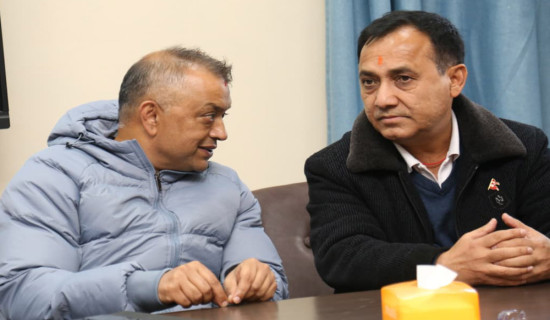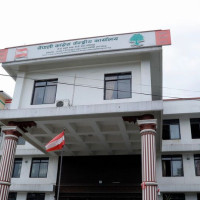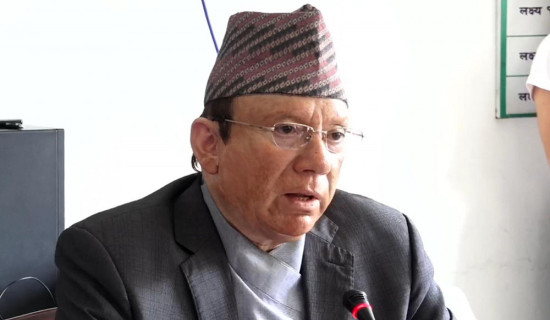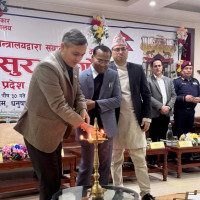- Wednesday, 14 January 2026
Why do the Lokeshwors have different colours?
Lalitpur, Apr. 27: The Rato Machhindranath Jatra began in Lalitpur on Monday. It began around a month after the Seto Machhindranath Jatra concluded in Kathmandu.
The two deities share many similarities. As the name suggests, they are both worshipped as Machhindranaths and also as Lokeshwors (gods who care for the entire universe). They are taken around their respective cities in similar-looking chariots. And they undergo similar consecration and Dasa Karma (10 initiations) rites. Yet, why are they differently coloured – Rato (red) and Seto (white)?
In fact, all four major Lokeshwors, worshipped by both Hindus and Buddhists of Kathmandu Valley, have quite a lot in common. The Rato Machhindranath, Padmapani Lokeshwor, of Lalitpur, the Seto Machhindranath, Aryavalokiteshwor, of Kathmandu, the Adinath or Anandadi Lokeshwor of Chovar and the Srishtikanta Lokeshwor of Nala, are all revered as Bodhisattva Karunamaya, dedicated to the welfare of all living beings. They have similar bathing and sanctification rituals. All four also have Jatras dedicated to them. But still, the question is, why are they differently coloured? Why do Padmapani Lokeshwor and Anandadi Lokeshwor have a scarlet complexion while Aryavalokiteshwor and Srishtikanta Lokeshwor are as fair as snow?
Yagya Ratna Shakya, chairman of the Shree Hyagriv Bhairavnath and 32 Paneju Association (SHBPA) of Rato Machhindranath, makes an interesting observation on this. The two Lokeshwors – of Lalitpur and Chovar – that face north when in their sanctums are red while the other two are white. So, is that all? “Certainly not,” he stressed.
Padmapani Lokeshwor, red Machhindranath of Lalitpur
Having two abodes at Bungamati and Tabahal, this deity, locally called Bunga Dya, is perhaps the most well-known of the four Lokeshwors. And, according to Yagya Ratna, there are three possible explanations as to why he is red.
The first one is because Amitabha Buddha, the most ancient of the Dhyani Buddhas, rests on top of Padmapani’s head. Amitabha represents an immeasurable light or a bright eternal flame and is red in colour. “The Amitabha Buddha could have imparted its colour on Bunga Dya,” he said.
But an image of Amitabha is found on the crowns of the other Lokeshwors. Furthermore, John K Locke, an American-born Jesuit who extensively studied Newar Buddhism, mentions in his 1980 book ‘Karunamaya: The Cult of Avalokitesvara – Matsyendranath in the Valley of Nepal’ that all Lokeshwors belong to the family of the Amitabha Buddha. So, shouldn’t that make all Machhindranaths red?
Yagya Ratna acknowledged this question and presented the second explanation.
“Lalitpur’s Rato Machhindranath is a divinity that represents the combined energies of the gods Brahma, Bishnu, Maheshwor and the Sun,” he shared. “The qualities of the brightly burning Sun make the god red.”
This presence of the Sun within the essence of Rato Machhindranath is why many important activities, including the changing of their residence from Bungamati to Tabahal, are guided by the solar calendar, he informed.
The third explanation of the god’s crimson colouration has to do with their lineage. “Bunga Dya was born into a family of demons (Rakshasa Kul). His colour is a reflection of that,” Yagya described.
Aryavalokiteshwor, white Machhindranath of Kathmandu
Because of their residence in Jana Bahal, Aryavalokiteshwor is called Jana Baha Dya in Nepal Bhasa.
Their white colour is what gives them the Nepali moniker Seto Machhindranath.
See Page 6
And the reason the lord here is white is because they hail from a divine lineage (Deva Kul) that is above our realm and beyond the constraints of mortal existence, informed Purna Ratna Bajracharya.
Purna Ratna, better known by the sobriquet Swoyambhu Guruju, is an astrologer, a member of the community that attends to the Machhindranath at Jana Bahal, a cultural researcher and an artist who has been painting the idols of Seto Machhindranath and Srishtikanta Lokeshwor for decades.
“Aryavalokiteshwor and Srishtikanta Lokeshwor are inherently divine which is why they are glowing white,” he described. “This is also why we do not necessarily need to fix auspicious moments to carry out rituals associated with these gods. With them, every moment is auspicious.”
Anandadi Lokeshwor of Chovar
Once upon a time, the Karunamaya of Chovar was yellow and had a chariot festival dedicated to it, just like Bunga Dya and Jana Baha Dya, Sarose Shakya, priest at the Anandadi Lokeshwor Temple and secretary of the Kakshapal Suvarnagiri Mahavihara Sudhar Samiti, told The Rising Nepal. One year, though, the chariot got stuck at present-day Balkhu and could not be moved for four days.
Using that as an opportunity, some Tibetans came and stole the idol of the yellow-faced god. However, despite taking the physical form of the god, they could take the soul, which remained in Nepal. After some time, the soul took the form of a red statue and appeared at the confluence of the Nakkhu and the Bagmati rivers.
A cowherd later discovered the idol and the people, after learning of the divinity within, and consecrated it at the temple left empty by the theft of the old figure. That is where it remains today, worshipped as Adinath or Anandadi Lokeshwor who cures diseases and physical ailments. The theft of the old idol is still re-enacted in the annual Adinath festival (which no longer consists of a chariot) celebrated in the Nepali month of Chaitra.
Today, the Lokeshwor is tended to by five Shakya families which, as Sarose informed, are believed to have been each brought from Pimbahal, Kwa Bahal (Golden Temple) and Tangal of Lalitpur and Jana Bahal of Kathmandu. One family is a native of Chovar itself. “Because one of our priestly families originally came from Jana Bahal, it is believed that if, for some reason, the priests of Jana Bahal are unable to fulfil their responsibilities, we can go there and serve the Seto Machhindranath in their stead,” he said.
Srishtikanta Lokeshwor of Nala
Srishtikanta Lokeshwor or Nala Karunamaya represents a unique coming together of the cults of Bunga Dya and Jana Baha Dya. The Panejus of Rato Machhindranath carry out the rituals associated with the god’s Jatra, which also does not include a wheeled chariot, that occurs around the time of Fagu Purnima (Holi) and members of the community related to the Seto Machhindranath carry out the painting.
As Purna Ratna, who has been painting the Nala idol for 50 years at this point, explained, Nala Karunamaya is white because of their innate divinity.
But local Rajendra Kumar Bajracharya, who is also the head teacher of Chandeshwori Secondary School, revealed that the deity was previously red because of its connection to Bungamati.
Locke mentions a legend in his book that states in the Satya Yuga, Karunamaya appeared in Nagiripur (Nala) in the form of goddess Chandradevi to guide King Dirgharatha and his people away from their wicked ways and end the famine that had befallen the land. The goddess’s arrival made everyone pious and brought great prosperity. But after some years, she was stolen and taken to Bungamati where she resided till Kali Yuga when a Kirati king stole her and threw her into the river.
The king was made to flee Bungamati and had intended to take her to a place where both he and the goddess would be safe and happy. But upon reaching a river, the goddess’s idol bit him, which angered him and he threw her into the water.
“The statue came floating to Nala and was established as Karunamaya,” Rajendra shared.
Because the deity spent centuries, perhaps millennia in Bungamati, and was worshipped by the local Panejus, they still hold the right to perform the ceremonies during the Nala Jatra. “They had also moulded the Lokeshwor in the image of Bunga Dya and had painted it red,” Rajendra informed.
This red look remained until the 1970s when there was a realisation that Srishtikanta Lokeshwor needed to be white.
“There was a debate and a lot was drawn to determine which colour the god wanted to be. It showed a favour for white and the idol was repainted.” Rajendra, who was just a child then, was the one who drew the lot.
Nevertheless, some suspected that the lot was wrong. After all, the god had been red for generations. But these suspicions were put to rest around 12 years ago when, to repair the sandalwood sculpture and prevent termites, all the paint was removed.
“Beneath the white paint were, as expected, layers of red paint. But beneath the red paint, we found that the idol was white. This confirmed the original colour of the deity.”














